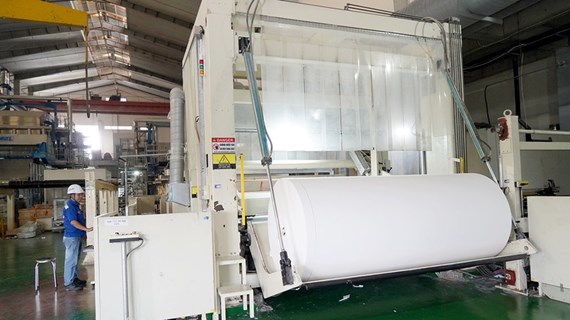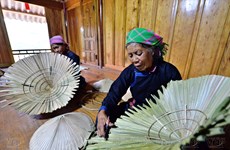Co Tu community preserves ancient culture
Approximately five kilometres off the centre of Tay Giang district, the
Porning village which has a population of 500, still preserves the
traditional culture, arts and customs of their ancestors. In fact, even
some of the practices in their community are based on the past rituals
of their forefathers.
Approximately five kilometres off the centre of Tay Giang district, the
Porning village which has a population of 500, still preserves the
traditional culture, arts and customs of their ancestors. In fact, even
some of the practices in their community are based on the past rituals
of their forefathers.
The guol still plays the role of the heart and soul of the community. It serves as a rendez-vous for all the big festivals and meetings held every year. In addition, the villagers still share the food if one of them is back from a successful hunt in the forest. The villagers also frequently gather as a community to discuss the younger generations' future.
Brothers Colau Nhat, 76, and Colau Nhap, 61, as well as cousin Colau Nam, 84, are the oldest in the Colau family living in the village. They serve as the guardians of the wooden sculpture of spiritual figures for the communal house.
Despite his old age, Nam still hunts. This is an old hobby he inherited from his ancestors. He also hunts to contribute to the food reserve of the village, which is kept for long winter days after the harvest.
The old Co Tu man is the 10th generation of the Colau family preserving the art of mask sculpture.
"It is a very old tradition. I'm the 10th generation pursuing this art for the village. I was told by my grandfather that the mask serves as the spiritual protection of village from evil spirits and devils," Nam said.
"Sculpture is the longest standing tradition of the Co Tu people. It appeared when the minority learned how to build the guol. The masks are believed to represent the souls of the dead, the good and the evil, while wood sculptures depict the daily lives of the Co Tu people."
Colau Nhap, 61, recalled that the mask used to hang on the village's gate and all columns of the guol - two spiritual places of Co Tu community - to drive away devils and protect the villagers from supernatural disasters.
"The mask is only used as a decoration for the two places. The ancestors of the Co Tu people believe that ugly and aggressive masks show off power and force devils to run away in terror," Nhap said.
"The best artisans or most skillful sculptors are allowed to make masks from the hardest parts of timber, which makes mask last undamaged for a long time," he explained.
"Carving on a 40cm diameter hard-wood is a difficult job as sculptors use knives and axes to create imaginary faces. A little mistake could damage the work. Therefore, only the best artisans are assigned to create the art," he said.
The 61-year-old, who is a veteran, said that the Co Tu people believed that the good and the bad or devils and angels exist together in the world.
He said craftsmen often create masks that are so ugly and monstrous, and have horns, big ears, long and white fangs in strong colours to depict evil.
"Traditionally, people think that devils are scared of bigger and more frightening masks. These masks are believed to prevent devils from threatening the community," he speculated.
Colours including yellow, red, white and brown were made naturally from charcoal, roots, lime stone, soil and raisin.
Nhap said that it took a month to finish a mask using manual tools. Moreover, masks were only made when a new village or a new guol was built.
He shared that their lives have changed gradually but significantly, and the centralised community lifestyle has all but disappeared.
"Local people prefer living near the main road to attain better business prospects. Only a few people pay attention to the gate of the village. However, the guol and the basic lifestyle are still preserved at the commune," he assured.
Pa Lang Bung, 45, said the guol exists as a typical feature and milestone of the Co Tu people and their land.
"Most of the villagers visit the guol for big meetings or major festivals. It's also the main place for celebrations during the new rice season and completion of a year of hard work, and falls in October," Bung said.
"Masks are often made when a community decides to rebuild the guol. The preparation takes the community months as each family is assigned a different task," explained Bung.
Youths seek timber in the forests for weeks before the artisans start working on the sculptures.
Bung said the construction of the guol often takes five or seven days. All members of the community participate. Moreover, the construction must be completed before October, which marks the beginning of a new festival season.
"October is the time that people finish all their tasks in their farms and homes. It's the start of the festive season, while some move into their new houses. The buffalo-stabbing festival is truly a joyous celebration."
Colau Nhat, 76, said the guol is a work of art of the Co Tu people. It depicts power and spirit of the community, as well as solidarity among its people.
"Two masks of God are hanged in the two columns of the main entrance door, while all the columns are decorated by masks depicting different figures. All the corners, walls, beams and girders of the house are carved with images of animals, human activities, hunting and dances," Nhat described.
"We recall all the animals we hunted in the forests and copy their images on wood. Snake, wild boar, horse, elephant, python, chamois, tiger panther, as well as some extinct animals, are included," Nhat recalled.
"Sculpture is an ancient method used by the Co Tu community to record life activities. Viewing these images provides the younger generations and visitors a partial understanding of our ancestors centuries ago," he said.
Deputy Chairman of Tay Giang's People's Committee, ARut Blui, said that the district retains 70 guol at every village.
"Guol is an indispensable mark of the Co Tu village when the district has been in the process of building new rural areas. The house is proud of the Co Tu people - the heart and soul of a longstanding culture and tradition," BLui said.
However, the vice chairman said that a number of poor people still accounted for 46.29 percent of the district's 17,000-population.
"The capita per head in the district is still low with 15 million VND (714 USD) per year. The district has grown 2,100ha of rubber with a target of 2,500ha with the hope of easing poverty among local people," BLui said.
BLui said the district has an area of 901sq.km, of which 75 percent is covered by forest.
He commented that forest protection plays a key role in boosting the socio-economic development for the future.-VNA
The guol still plays the role of the heart and soul of the community. It serves as a rendez-vous for all the big festivals and meetings held every year. In addition, the villagers still share the food if one of them is back from a successful hunt in the forest. The villagers also frequently gather as a community to discuss the younger generations' future.
Brothers Colau Nhat, 76, and Colau Nhap, 61, as well as cousin Colau Nam, 84, are the oldest in the Colau family living in the village. They serve as the guardians of the wooden sculpture of spiritual figures for the communal house.
Despite his old age, Nam still hunts. This is an old hobby he inherited from his ancestors. He also hunts to contribute to the food reserve of the village, which is kept for long winter days after the harvest.
The old Co Tu man is the 10th generation of the Colau family preserving the art of mask sculpture.
"It is a very old tradition. I'm the 10th generation pursuing this art for the village. I was told by my grandfather that the mask serves as the spiritual protection of village from evil spirits and devils," Nam said.
"Sculpture is the longest standing tradition of the Co Tu people. It appeared when the minority learned how to build the guol. The masks are believed to represent the souls of the dead, the good and the evil, while wood sculptures depict the daily lives of the Co Tu people."
Colau Nhap, 61, recalled that the mask used to hang on the village's gate and all columns of the guol - two spiritual places of Co Tu community - to drive away devils and protect the villagers from supernatural disasters.
"The mask is only used as a decoration for the two places. The ancestors of the Co Tu people believe that ugly and aggressive masks show off power and force devils to run away in terror," Nhap said.
"The best artisans or most skillful sculptors are allowed to make masks from the hardest parts of timber, which makes mask last undamaged for a long time," he explained.
"Carving on a 40cm diameter hard-wood is a difficult job as sculptors use knives and axes to create imaginary faces. A little mistake could damage the work. Therefore, only the best artisans are assigned to create the art," he said.
The 61-year-old, who is a veteran, said that the Co Tu people believed that the good and the bad or devils and angels exist together in the world.
He said craftsmen often create masks that are so ugly and monstrous, and have horns, big ears, long and white fangs in strong colours to depict evil.
"Traditionally, people think that devils are scared of bigger and more frightening masks. These masks are believed to prevent devils from threatening the community," he speculated.
Colours including yellow, red, white and brown were made naturally from charcoal, roots, lime stone, soil and raisin.
Nhap said that it took a month to finish a mask using manual tools. Moreover, masks were only made when a new village or a new guol was built.
He shared that their lives have changed gradually but significantly, and the centralised community lifestyle has all but disappeared.
"Local people prefer living near the main road to attain better business prospects. Only a few people pay attention to the gate of the village. However, the guol and the basic lifestyle are still preserved at the commune," he assured.
Pa Lang Bung, 45, said the guol exists as a typical feature and milestone of the Co Tu people and their land.
"Most of the villagers visit the guol for big meetings or major festivals. It's also the main place for celebrations during the new rice season and completion of a year of hard work, and falls in October," Bung said.
"Masks are often made when a community decides to rebuild the guol. The preparation takes the community months as each family is assigned a different task," explained Bung.
Youths seek timber in the forests for weeks before the artisans start working on the sculptures.
Bung said the construction of the guol often takes five or seven days. All members of the community participate. Moreover, the construction must be completed before October, which marks the beginning of a new festival season.
"October is the time that people finish all their tasks in their farms and homes. It's the start of the festive season, while some move into their new houses. The buffalo-stabbing festival is truly a joyous celebration."
Colau Nhat, 76, said the guol is a work of art of the Co Tu people. It depicts power and spirit of the community, as well as solidarity among its people.
"Two masks of God are hanged in the two columns of the main entrance door, while all the columns are decorated by masks depicting different figures. All the corners, walls, beams and girders of the house are carved with images of animals, human activities, hunting and dances," Nhat described.
"We recall all the animals we hunted in the forests and copy their images on wood. Snake, wild boar, horse, elephant, python, chamois, tiger panther, as well as some extinct animals, are included," Nhat recalled.
"Sculpture is an ancient method used by the Co Tu community to record life activities. Viewing these images provides the younger generations and visitors a partial understanding of our ancestors centuries ago," he said.
Deputy Chairman of Tay Giang's People's Committee, ARut Blui, said that the district retains 70 guol at every village.
"Guol is an indispensable mark of the Co Tu village when the district has been in the process of building new rural areas. The house is proud of the Co Tu people - the heart and soul of a longstanding culture and tradition," BLui said.
However, the vice chairman said that a number of poor people still accounted for 46.29 percent of the district's 17,000-population.
"The capita per head in the district is still low with 15 million VND (714 USD) per year. The district has grown 2,100ha of rubber with a target of 2,500ha with the hope of easing poverty among local people," BLui said.
BLui said the district has an area of 901sq.km, of which 75 percent is covered by forest.
He commented that forest protection plays a key role in boosting the socio-economic development for the future.-VNA













